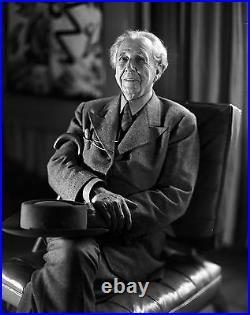This photo is printed from original negative. Frank Lloyd Wright was an American architect, interior designer, writer, and educator, who designed more than 1,000 structures, 532 of which were completed. Wright believed in designing structures that were in harmony with humanity and its environment, a philosophy he called organic architecture. This philosophy was best exemplified by Fallingwater, which has been called “the best all-time work of American architecture”. Wright was a leader of the Prairie School movement of architecture and developed the concept of the Usonian home, his unique vision for urban planning in the United States. In the history of twentieth-century fashion and portrait photography, Horst’s contribution figures as one of the most artistically significant and long lasting, spanning as it did the sixty years between 1931 and 1991. During this period, his name became legendary as a one-word photographic byline, and his photographs came to be seen as synonymous with the creation of images of elegance, style and rarefied glamour. Born on 14 August 1906, Horst Paul Albert Bohrmann was the second son of a prosperous middle class Protestant shop owner, Max Bohrmann and his wife, Klara Schoenbrodt. Horst The first pictures that carried a Horst credit line appeared in the December 1931 issue of French. It was a full-page advertisement showing a model in black velvet holding a Klytia scent bottle in one hand with the other hand raised elegantly above it… Horst’s real breakthrough as a published fashion and portrait photographer was in the pages of British. Starting with the 30 March 1932 issue showing three fashion studies and a full-page portrait of the daughter of Sir James Dunn, the art patron and supporter of Surrealism. War was declared between America and Germany on 7 December 1941. Horst was called up for service, though he was not officially enrolled until July 1943. The late 1930s and early 1940s were his most productive years, during which he excelled at working with 10-x-8 inch colour transparencies both for covers and for portrait and fashion sittings… As a typical example of wartime escapism, the Rita Hayworth film. (1944) provided Horst with the opportunity to produce one of his most sumptuous film-star covers in a montage of seven different portraits of the cover girl Susann Shaw set against a silk design. His picture of Loretta Young became an almost immediate classic when it was featured in a special edition of. Which included masterpieces of photography selected by (classic photographer Edward) Steichen to show off the first hundred years of the medium. Pictures taken in Europe in the 1950s, away from studio interference from the new. Editor, had a startling plein-air quality. They ranged from Ian Fleming shot at Kitzbeuhel to an extended essay on the German conductor Herbert von Karajan in his modern sports car at his Austrian retreat… Horst’s first important trip to Austria occurred in 1952, to work on a major advertising campaign with the new model Suzy Parker, who would become a major star in the 1960s before attempting a film career. In America that same year, he took his first lifestyle house and interior photographs; the sitter was Consuelo Vanderbilt, Duchess of Marlboro and now MMe. This series, encouraged by Diana Vreeland during her time at Vogue, was to continue into the 1980s in both. And was to be collected in the book. By Barbara Plumb (1983). The 1960s started well for American Vogue with the appointment of the larger than life’Empress of Fashion’, Diana Vreeland, as Editor-in-Chief. Vreeland served from 1961 until 1971, when a change of approach was deemed necessary. Horst was assigned some of the leading players of the time and produced a number of archetypal images of this energetic decade. The 1970s remains the decade that good, timeless style overlooked, and work for Horst was necessarily sparse… However, Horst’s rediscovery by a new group of 1980′s style-seeking enthusiasts resulted in increasing commissions… Horst was commissioned to take nine photographs which appeared in February 1980. This was the most popular issue of. Return Engagement: Faces to Remember – Then and Now. Horst’ career can be said to have reached Old Master status when the world’s most famous pop goddess, Madonna, created her celebrated hymn to classic fashion photography with her single. In the video directed by David Fincher, she posed as a recreation of Horst’s most iconic fashion image, a model seen from behind, wearing a partially tied, back-laced corset made by Detolle. In his approach to portraiture, Horst set out to create a parallel aspirational universe in which his subjects became mysterious and alluring. Bruce Weber, one of many photographers influenced by Horst, artfully described his feelings about Horst’s work in a 1992 television documentary:’The elegance of his photographs… Took you to another place, very beautifully… The untouchable quallity of the people is really interesting as it gives you something of a distance… It’s like seeing somebody from another world… And you wonder who that person is and you really want to know that person and really want to fall inlove with that person’. – excerpted from Terrence Pepper’s essay “Always in Vogue” from the book. Horst Portraits, 60 Years of Style. National Portrait Gallery, London, 2001.
Posts tagged horst
